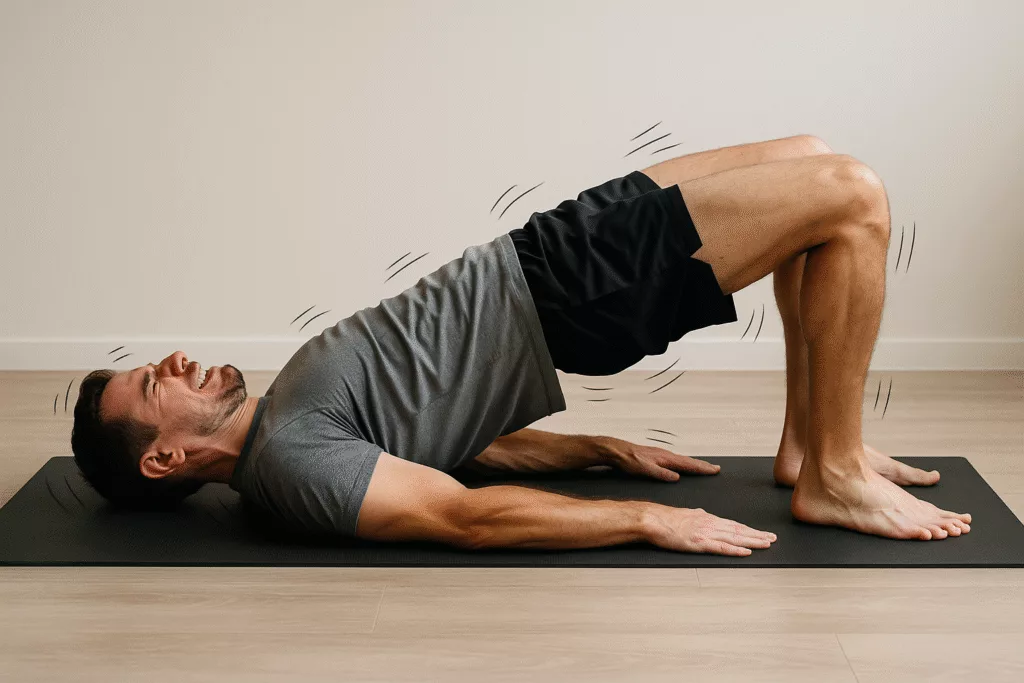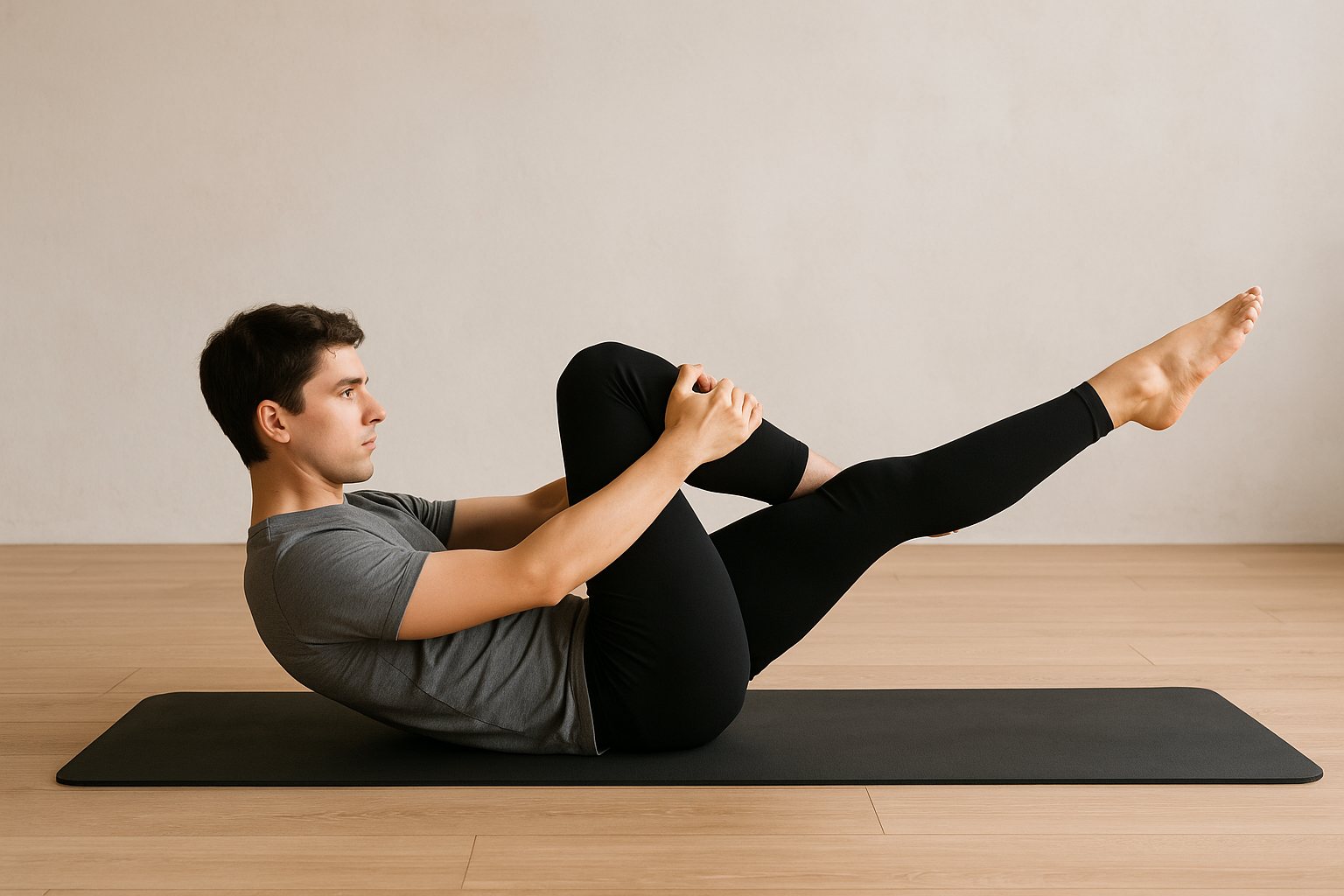Ok, let’s be real right from the start
I’ve lifted barbells that made the floor creak.
I’ve squatted until I saw stars.
I’ve gotten forearm cramps from weighted pull-ups like the world was ending.
But then I tried Pilates.
And suddenly, while trying to hold what looked like an innocent position with one leg raised and hands behind my head…
The seismic alarm went off.
I was shaking all over.
Thighs, abs, eyebrows.
And I asked myself:
How is it possible I’m shaking more now than when I bench 220 pounds?
No, you’re not weak. You’re just asking your brain to become a tightrope walker

When you lift weights, your body moves along familiar tracks.
You push. You pull. You contract. You relax.
The big muscles know exactly what to do.
The movement is large, powerful, mechanical.
But in Pilates?
You enter another world.
One where “activating” a muscle isn’t enough.
You have to keep it activated, controlled, lengthened, balanced… all at once.
You’re asking your central nervous system to host a conference between tiny stabilizer muscles while trying not to fall over like a sack of potatoes.
The shaking?
That’s your brain trying to sync everything in real time.
Something like:
“Wait… should I engage the iliopsoas or the internal oblique? Is my foot levitating on its own? Why is my quad sweating?”
Strength training and stability training are two completely different movies
The barbell doesn’t ask for balance.
It asks for strength, willpower, focus.
But it supports you.
In Pilates, everything is unstable.
You place half a shoulder blade on the mat, lift a leg, and suddenly you’re clenching your glutes just to stay upright.
Even if you’re doing something that looks “easy.”
It’s like trying to write a letter with your foot while walking on a tightrope.
Strength is there.
But it’s not enough.
You need coordination.
You need neuromuscular endurance.
You need surgical precision.
Your core isn’t just abs. And Pilates knows that.
In the weight room, “core” usually means your front abs:
- Rectus abdominis
- External obliques
The ones you see in the mirror.
But Pilates trains your deep core — the famous “deep core”:
- Transversus abdominis
- Pelvic floor
- Multifidus
- Diaphragm
All those muscles you can’t see but that stabilize your body from the inside.
And you know what happens when you ask those tiny guys to finally do their job?
They shake.
Because they’re like office workers on their first day without a manual.
Eccentric control is the silent killer

You know what no one ever tells you about Pilates?
The hardest part is going down slowly.
In the gym, the eccentric phase (the lowering) is often fast, almost automatic.
Down, up, done.
But in Pilates…
Every descent is a test.
You have to control every inch, sometimes one vertebra at a time.
They’ll ask you to “articulate the spine,”
To “avoid compensating with your lower back,”
To “relax your shoulders but keep your center active.”
And while you try to do all of that at once,
Your legs shake like branches in the wind.
Worst part?
No one saves you.
There’s no bar to drop or bench to sit on.
Just you, the mat… and your pride sliding away with the sweat.
Shaking? Good. You’re growing. Literally.
The shaking isn’t a flaw.
It’s a signal.
A signal that your neuromuscular system is building new connections,
That you’re waking up dormant muscles,
That you’re finally asking your body to do something different.
It’s like learning to ride a motorcycle after years on a bicycle:
The balance feels familiar, but the control is a whole different game.
And over time?
The shaking fades.
Not because it gets easier, but because you get stronger, more precise, more aware.
The science behind the shake 🧠
To back it up, there are several studies explaining why Pilates makes you shake — and it’s legit, not just gym gossip.
It’s not about lack of strength or even fatigue.
It’s a sign that you’re training brain connections, not just muscles.
Here’s why:
📌 1. Shaking is a sign of neuroplasticity
According to recent studies on motor learning, shaking during precision exercises — like Pilates — is linked to neural plasticity: the brain forming new connections with the body.
Every time you shake, it means you’re breaking out of an old motor pattern and creating a new one.
You’re not just moving a muscle.
You’re building a road between your brain and muscle fibers.
A study in Nature Reviews Neuroscience highlights that when performing high-demand sensorimotor tasks (like holding a teaser or roll-up), the brain activates a brand new, temporary map.
And that shake?
Is that map forming.
Each jolt is a neural bridge struggling to stabilize… but once it does, it sticks.
📌 2. More control = deeper fiber recruitment
Pilates doesn’t just train visible muscles — it targets deep, hard-to-activate ones.
A study on PubMed analyzed activity in the multifidus (one of the deepest spinal muscles, essential for lumbar stability) and found that Pilates practitioners show more neuromuscular activation and coordination than those trained only with traditional exercises.
Why do you shake? Easy:
You’re waking up muscles that have been sleeping for years, now suddenly under the stress of precision and endurance.
These muscles don’t have “explosive power,” but they’re responsible for millimetric stability.
Keeping them active in a static position under tension is exactly what causes that unmistakable shake.
📌 3. Shaking comes from poor initial coordination
Chelsea Corley, a motor learning and postural control expert, explains that shaking comes from a temporary delay in motor neuron synchronization.
Basically, the brain knows what you want to do, but hasn’t optimized how to tell the muscles yet.
It’s like sending voice messages to a friend with bad signal: they arrive, but in bits.
During your first attempts, this delay shows up as shaking.
But the more you repeat the movement consciously and slowly, the smoother the information flow becomes.
Motor learning research confirms it: slow, precise repetition accelerates the creation of more stable, lasting motor patterns.
Result?
Less shaking, more control, better efficiency.
📌 4. Enhanced reactivity and postural awareness
While most tremor studies focus on neurological diseases, there’s an interesting area of research on unstable training — like waterbag workouts or unstable surfaces.
A study in MDPI showed that regular exposure to controlled instability improves:
- Anticipatory postural reflexes
- Muscle reaction times
- Intermuscular coordination under stress
Pilates does exactly that:
It puts you in situations where your body must activate in advance to maintain balance.
Every micro-imbalance, every small pelvic rotation, every breath that shifts tension… is a new input to manage.
The shaking?
It’s the automatic, reflexive response to all those signals.
It’s your body saying:
“I’m trying to handle all this… but I need a sec.”
What to do when you start shaking like a blender
Don’t panic.
It’s not a weakness attack.
It doesn’t mean you’re “out of shape.”
It means you’re triggering new muscles and new connections.
And that’s exactly why you’re here.
The more you shake today,
The more stable you’ll be tomorrow.
The more you wobble now,
The more inner strength you’re building.
When shaking is normal… and when it’s not
Let’s be clear:
Shaking during Pilates is totally normal.
But there’s a thin line between “challenging your stability” and “risking injury.”
How do you tell the difference?
- If the shake is symmetrical (both legs or both sides of your core), you’re good.
- If you feel a sudden jolt in one spot, especially with pain or loss of control… stop.
- If the shake is so strong you lose alignment or “collapse” the position, regress to a simpler version.
Pilates isn’t a contest to see who holds out the longest.
It’s a journey of precision, control, and self-awareness.
How to reduce shaking over time (without avoiding it entirely)
Shaking is useful, yes.
But that doesn’t mean you have to suffer through it like it’s your first day of school every time.
Here are a few strategies to build stability faster:
- Use smart regressions: Do the easier version of the exercise until you can control it for 30–40 seconds. Then level up.
- Use props: Small pillows, bands, blocks, or even a wall can help “educate” your muscles without sacrificing quality.
- Add isometric holds to your warm-up, like static planks or glute bridges, to activate your deep core before starting.
- Train your breath: Diaphragmatic breathing (real breathing, not half-baked yoga book breathing) gives you internal stability and helps you “stabilize from within.”
Don’t avoid the shake.
Learn to modulate it and use it to your advantage.
What if you’re already “gym trained”?
If you already squat, deadlift, military press and all that…
You probably expect to crush it in Pilates too.
And then — BAM: you’re humbled by a bodyweight position.
Why?
Because the motor system adapts specifically.
Being strong in closed-chain exercises (like barbell squats) doesn’t mean you can control a floating leg while your pelvis wants to rotate.
A “strong body” isn’t always a “well-educated body.”
And Pilates, in a way, re-educates you.
But here’s the good news:
The strength you built in the gym can massively speed up your Pilates progress.
You just need to lower your pride a bit and start from scratch.
What if the shaking comes from hidden imbalances?
I know, it sounds weird.
But sometimes the shaking doesn’t just come from effort or an updating brain.
It comes from having one side that’s been doing more work for years.
A lot of us — especially weightlifters — have imbalances that stay hidden until you’re put into a symmetrical, vulnerable position.
And guess what?
Pilates is full of those.
A one-legged glute bridge, a V-hold with both legs extended, a torso rotation without using the shoulders…
In those situations, if one side is weaker, stiffer, or less coordinated — you shake.
Everything seems to collapse from just one side.
And no, it’s not because “that side isn’t strong.”
It might just be using different strategies to stabilize, or relying too much on other muscles (like quads doing the glutes’ job).
Postural and activation imbalances are common if you:
- Have a much stronger dominant side
- Do bilateral exercises with uneven load distribution
- Had past injuries that caused unconscious compensations
- Spend many hours sitting or in imbalanced posture
And Pilates doesn’t forgive.
It places you in a corner, with your body, and says:
“Now let’s see how you balance this instability.”
But there’s good news:
That shaking is your first sign of rebalancing.
Because as soon as your body is placed in a neutral, compensation-free setting,
It starts to reveal differences…
And fix them automatically.
At that point, it’s no longer about just training.
It’s about re-educating your body to functional symmetry — one of the most underrated but powerful things you can do if you’re serious about training.
Conclusion
I’ll keep training with weights.
Always.
Because I love the feeling of raw power.
I love PRs.
I love the metallic clang of the plates.
But Pilates taught me that real strength is also quiet, deep, and controlled.
And if today you’re shaking like a leaf…
Know that you’re tapping into something powerful.
Shaking isn’t a sign of failure.
It’s the start of a new kind of strength,
The kind that doesn’t make a scene…
But holds everything else together.
Go.
Shake.
Build.
And don’t laugh too hard during the “hundred”…
Tomorrow your core will send you the bill.

